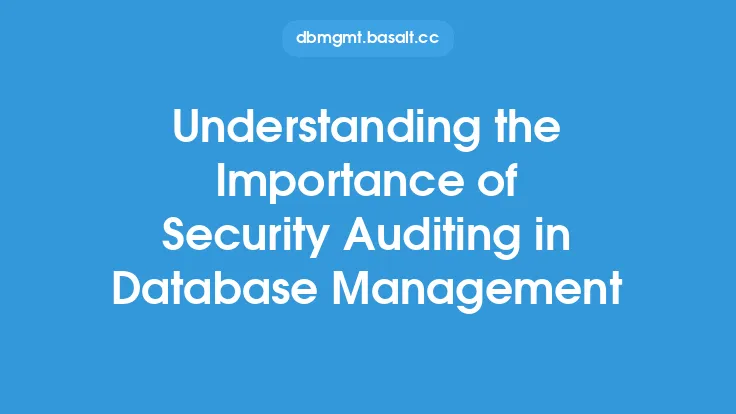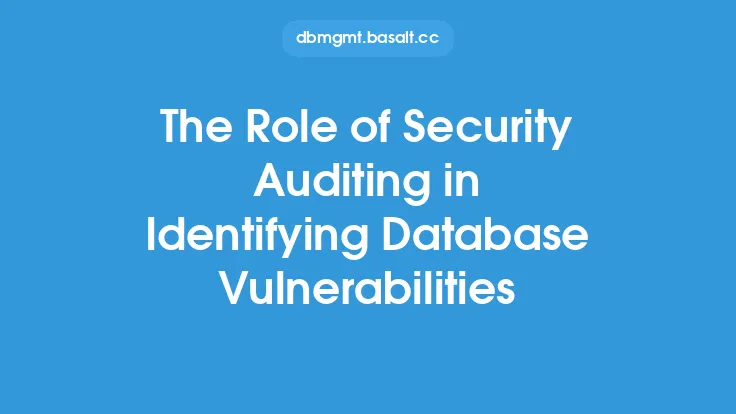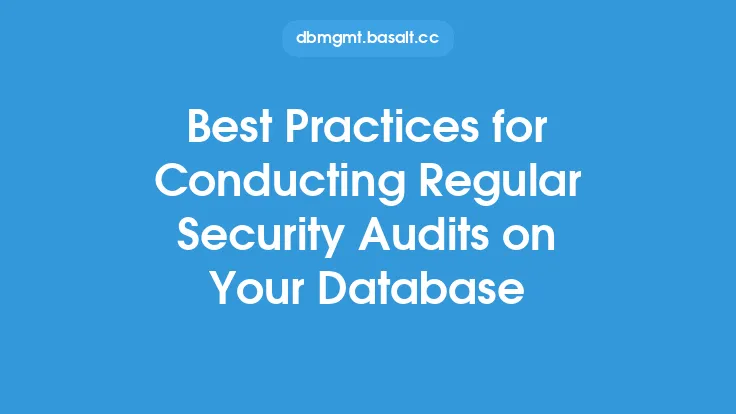Implementing automated security auditing tools for your database is a crucial step in ensuring the integrity and security of your data. With the increasing number of cyber threats and data breaches, it is essential to have a robust security system in place to protect your database from unauthorized access and malicious activities. Automated security auditing tools can help you identify vulnerabilities, detect threats, and prevent data breaches, thereby providing a secure environment for your data to reside.
What are Automated Security Auditing Tools?
Automated security auditing tools are software applications that use advanced algorithms and techniques to scan your database for security vulnerabilities and threats. These tools can identify potential risks, detect anomalies, and provide recommendations for remediation. They can also help you comply with regulatory requirements and industry standards, such as PCI-DSS, HIPAA, and GDPR. Automated security auditing tools can be categorized into two main types: vulnerability scanners and compliance scanners. Vulnerability scanners identify potential vulnerabilities in your database, such as outdated software, weak passwords, and misconfigured settings. Compliance scanners, on the other hand, check your database for compliance with regulatory requirements and industry standards.
Benefits of Implementing Automated Security Auditing Tools
The benefits of implementing automated security auditing tools for your database are numerous. Some of the most significant advantages include:
- Improved Security: Automated security auditing tools can help you identify vulnerabilities and threats in real-time, allowing you to take prompt action to prevent data breaches and unauthorized access.
- Increased Efficiency: Automated security auditing tools can save you time and resources by automating the auditing process, allowing you to focus on other critical tasks.
- Enhanced Compliance: Automated security auditing tools can help you comply with regulatory requirements and industry standards, reducing the risk of non-compliance and associated penalties.
- Better Risk Management: Automated security auditing tools can help you identify potential risks and provide recommendations for remediation, allowing you to manage risks more effectively.
- Reduced Costs: Automated security auditing tools can help you reduce costs associated with manual auditing, such as labor costs and consulting fees.
Key Features of Automated Security Auditing Tools
When selecting an automated security auditing tool for your database, there are several key features to consider. Some of the most important features include:
- Vulnerability Scanning: The ability to identify potential vulnerabilities in your database, such as outdated software, weak passwords, and misconfigured settings.
- Compliance Scanning: The ability to check your database for compliance with regulatory requirements and industry standards.
- Real-time Monitoring: The ability to monitor your database in real-time, allowing you to detect threats and vulnerabilities as they occur.
- Alerting and Notification: The ability to send alerts and notifications to designated personnel in the event of a security incident or vulnerability detection.
- Reporting and Analytics: The ability to generate detailed reports and analytics, providing insights into your database security posture.
How to Implement Automated Security Auditing Tools
Implementing automated security auditing tools for your database requires careful planning and execution. Here are some steps to follow:
- Assess Your Database Security Posture: Conduct a thorough assessment of your database security posture to identify potential vulnerabilities and threats.
- Select an Automated Security Auditing Tool: Select an automated security auditing tool that meets your needs and requirements.
- Configure the Tool: Configure the tool to scan your database for vulnerabilities and threats.
- Monitor and Analyze Results: Monitor and analyze the results of the scan to identify potential risks and vulnerabilities.
- Remediate Vulnerabilities: Remediate vulnerabilities and threats identified during the scan.
Best Practices for Using Automated Security Auditing Tools
To get the most out of automated security auditing tools, it is essential to follow best practices. Some of the most important best practices include:
- Regularly Update the Tool: Regularly update the tool to ensure you have the latest vulnerability signatures and compliance checks.
- Configure the Tool Correctly: Configure the tool correctly to ensure it is scanning your database for the right vulnerabilities and threats.
- Monitor Results: Monitor the results of the scan to identify potential risks and vulnerabilities.
- Remediate Vulnerabilities: Remediate vulnerabilities and threats identified during the scan.
- Continuously Monitor Your Database: Continuously monitor your database for security incidents and vulnerabilities.
Common Challenges and Limitations
While automated security auditing tools can provide numerous benefits, there are also common challenges and limitations to consider. Some of the most significant challenges and limitations include:
- False Positives: Automated security auditing tools can generate false positives, which can lead to unnecessary remediation efforts.
- False Negatives: Automated security auditing tools can also generate false negatives, which can lead to undetected vulnerabilities and threats.
- Complexity: Automated security auditing tools can be complex to configure and use, requiring specialized skills and expertise.
- Cost: Automated security auditing tools can be expensive, especially for large and complex databases.
Conclusion
Implementing automated security auditing tools for your database is a crucial step in ensuring the integrity and security of your data. These tools can help you identify vulnerabilities, detect threats, and prevent data breaches, thereby providing a secure environment for your data to reside. By following best practices and considering common challenges and limitations, you can get the most out of automated security auditing tools and ensure the security and compliance of your database.





